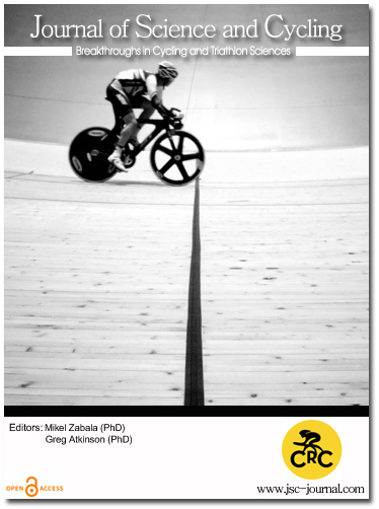Calculation of rear brake power and rear brake work during skidding on paved and gravel cycling surfaces
DOI:
https://doi.org/10.28985/1920.jsc.06Keywords:
power meter, brake power meter, cycling, skiddingAbstract
The use of a brake power meter at each wheel of a bicycle is a valid means to calculate energy losses due to braking. However, methodology utilizing the torque and angular velocity at each wheel independently are not able to reflect energy lost to braking when the rear wheel is skidding. This study tested the possibility of using the angular velocity of the front wheel, but the torque of the rear brake, to calculate rear brake power. Two cyclists completed 100 braking trials across three days on a mixture of paved and gravel surfaces with a mixture of skidding and non-skidding. The estimated total energy removed from the bicycle-rider system was calculated as the sum of brake work and estimates of drag and rolling resistance. This energy removed from the bicycle-rider system displayed a strong positive relationship with the change in kinetic energy of the bicycle-rider system during braking on paved (r2=0.955; p<0.0001) and gravel surfaces paved (r2=0.702; p<0.0001). There was no difference between these measurements overall (p<0.05), however there is some error of measurement when skidding on gravel. The findings in the present investigation indicate that rear brake work is underestimated when using the angular velocity at the rear wheel during skidding, but that utilising the angular velocity of the front wheel is a valid means of calculating rear brake power. Care should be taken when skidding on gravel as it is difficult to assess the linear velocity of the bicycle.Downloads
Published
How to Cite
Issue
Section
Copyright (c) 2019 Journal of Science and Cycling

This work is licensed under a Creative Commons Attribution-NonCommercial 4.0 International License.
Authors contributing to Journal of Science and Cycling agree to publish their articles under a Creative Commons CC BY-NC-ND license, allowing third parties to copy and redistribute the material in any medium or format, and to remix, transform, and build upon the material, for any purpose, even commercially, under the condition that appropriate credit is given, that a link to the license is provided, and that you indicate if changes were made. You may do so in any reasonable manner, but not in any way that suggests the licensor endorses you or your use.
Authors retain copyright of their work, with first publication rights granted to Cycling Research Center.






